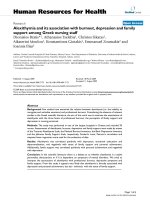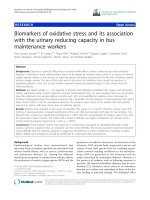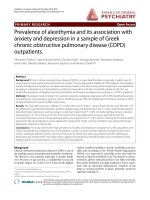A study on positive stone culture and its association with rate of sepsis after urological procedures
Bạn đang xem bản rút gọn của tài liệu. Xem và tải ngay bản đầy đủ của tài liệu tại đây (157.1 KB, 7 trang )
Int.J.Curr.Microbiol.App.Sci (2019) 8(2): 1015-1021
International Journal of Current Microbiology and Applied Sciences
ISSN: 2319-7706 Volume 8 Number 02 (2019)
Journal homepage:
Original Research Article
/>
A Study on Positive Stone Culture and its Association with Rate of Sepsis
after Urological Procedures
Sarita Rawat*, Vikas Verma, Naveen Saxena and Namita Garg
Department of Microbiology and Department of Urology, GMC Kota, India
*Corresponding author:
ABSTRACT
Keywords
Urolithiasis,
Urosepsis, Stone
culture
Article Info
Accepted:
10 January 2019
Available Online:
10 February 2019
This prospective study was done to determine correlation between urine and/or stone
cultures with postoperative sepsis in patients treated for renal and ureteral calculi. This
prospective study was carried out in Department of Microbiology, Government medical
college Kota between July 2015 and June 2016. The incidence of renal stone was more in
male (N 70) (70%) as compared with female (N 30) (30%) i.e., in the ratio of 2:1. Urine
culture was positive more in females (63.67% in female vs. 37.32% in male approx. ratio
2:1), however infected stone rates are almost similar in male and female (64.67% in male
vs. 62.60% in female). Out of 100 patients 43 cases showed infection in preoperative urine
culture, while rests 57 were sterile. Similarly 64 patients were positive for stone culture
and rest 36 were sterile. 28 patients had both stone and urine culture positive. Most
common bacteria isolated in urine culture were E. coli, Klebsiella positive urine culture)
cases. Post operatively 35% (N 35) patient show signs of SIRS. Out of 35 patients who had
sepsis 30 patients were positive for stone culture while 20 patients were positive for urine
culture. The result was significant on chi square test (Observed P value is 0.036). The
results of this study suggest that in patients undergoing surgery for urolithiasis, stone
cultures are better predictors of urosepsis than bladder urine C and S. Positive stone culture
may guide clinicians regarding selection of antibiotics, especially in cases of severe
urosepsis.
Introduction
USD
is
an
expanding
problem.
Approximately 10% of people will have a
urinary stone during their lifetime (1). The
key component in urinary stone formation is
supersaturation, a process by which the
concentration of substances in urine, such as
calcium and oxalate, exceed the limits of their
solubility (2). The bacterial contribution to
USD formation has long been recognized.
Incidence of urinary tract infection in stone
patients varies from 7% to 60% reported in
previous studies. The predominant bacteria
found in the nuclei of urinary calculi are
Staphylococcus and Escherichia coli. Urea
splitting
organisms
like
Proteus,
Pseudomonas and Klebsiella are under the
urine alkaline and hence are known to
promote stone formation in both clinical and
experimental studies. These are the required
conditions for the formation of magnesium
1015
Int.J.Curr.Microbiol.App.Sci (2019) 8(2): 1015-1021
ammonium phosphate calculi which are
generally staghorn. Other bacteria like E. coli
commonly observed in urinary infection are
not urea splitting. (3) For study of aetiology
and treatment of patients with urinary calculi
it is necessary to perform urine and stone
culture. Urinary tract infection and urinary
stone can trigger a Systemic Inflammatory
Response Syndrome (SIRS) before, during or
after medical treatment (i.e. antibiotics)
and/or surgical manipulation of infected
urinary stones. It is believed that SIRS is due
to the release of bacteria and their endotoxins
from infected urinary stones, developing
endotoxemia, bacteremia and urosepsis. Stone
may be infected with a different organism
than that infecting the bladder and urine. Low
Penetration of antibiotics in the stone prevents
complete eradication of urinary tract infection
by conventional antibiotic therapy and thus
leads to development of resistant organisms
with intermittent shedding in urine. In this
prospective study we shall determine the
correlation between different sites of urine
sampling, including stones.
Materials and Methods
This prospective study was carried out in
Department of Microbiology, Government
medical college Kota between July 2015 and
June 2016.
Patients with urogenital malignancy, others
cause of sepsis and those who were severely
immunocompromised were excluded from the
study. Before giving antibiotic treatment preoperative mid-stream sample of urine was
collected in sterile container after cleaning the
external genital organs. Samples were
inoculated using calibrated (4mmdia.) loop on
blood agar and MacConkeys agar. Cultures
were incubated at 37°C for 24 hours. Also
microscopy and Gram stain of urine samples
were performed. 3-7If no growth observed
after 24 hours of incubation samples were
considered sterile. The identification of
bacterial isolate was done by using standard
biochemical test. Antibiotic sensitivity was
done by using disc diffusion (Kirby and Baur)
method. The sensitivity of organisms to
antibiotics will be studied (Ampicillin,
chloramphenicol, tetracyclin, floroquinolones,
cephalosporin
group
of
antibiotics,
imepenem, meropenem aminoglycosides,
macrolide group of antibiotics, linezolid etc.
Urinary calculus was collected after the
operation in a sterile container. Culture of
calculus by giving 4-5 washes and finally by
crushing the calculus in sterile mortar and
pestle with 5ml in sterile saline, The crushed
calculi core was cultured in 5 ml thioglycolate
broth which was incubated at 37°C for 18-24
hours, and then subcultures were made on
blood agar and Mac Conkey’s agar plate for
isolation of etiological agents (9,10,11).
Cultures were incubated at 37°C for 24 hours.
The growth from culture plates were
examined for number of colonies. The
identification of bacterial isolates was done
by conventional methods. Also the antibiotic
sensitivity of bacterial isolates was done by
using disc diffusion (Kirby Baur) method (8)
Results and Discussion
Total 100 cases of urolithiasis were enrolled
in this study out of which70 were male and 30
were female.
Out of 100 patients observed 43 cases showed
infection in preoperative urine culture, while
rest 57 were urine culture sterile. Similarly 64
patients were positive for stone culture and
rest 36 were sterile. 28patients had both stone
and urine culture positive.
Urine culture was positive more in females
(63.67% in female vs. 37.32% in male
approx. ratio 2:1), however infected stone
rates are almost similar in male and female
(64.67% in male vs. 62.60% in female).
1016
Int.J.Curr.Microbiol.App.Sci (2019) 8(2): 1015-1021
Most common bacteria isolated in urine
culture were E. coli (24.44%), Klebsiella
(17.77%), Pseudomonas (13.33%) coagulase
negative
Staphylococcus
(17.77
and
Enterococcus 8.88%), etc.
Preoperative urine culture results
Most of the bacteria isolated from urine
culture were resistant to all antibiotics
(32.33%), 33.11% of these showed sensitive
to carbapenem group of antibiotics, 25.67% to
third generation cephalosporin, 21% to
floroquinolons
and
17.71%
to
aminoglycosides.
The comparison of micro-organisms isolated
from pre-operative urine, showed that E. coli
was predominant whereas from predominant
organism isolated from crushed stone core
culture was Klebsiella.
Most of these organisms (40%) were resistant
to all antibiotic, 36% show sensitivity to
carbapenem group of antibiotic, 16% to 3rd
generation cephalosoprins, 12 % to
floroquinolons and 10% to aminoglycosides
Stone culture was done in all 100 cases, out of
which 64% of stone were culture positive. In
20 patients previous urine culture was
positive and in remaining 24 patients previous
urine culture was negative (only stone culture
positive).
Post operatively 35% (N 35) patient show
signs of SIRS. Out of which 30 were stone
core culture positive. 20 Patients had urine
culture positivity. p value was significant in
for both urine and stone culture.
Bacteria and USD are clinically associated
because they often occur in the same patients
and USD patients often have positive urine
and/or stone cultures. Antibiotics prophylaxis
has been done in accordance with European
Association of Urology (modified from
Infectious Diseases Society of America, and
European Society of Clinical Microbiology
and Infectious Diseases) guidelines.12
Urosepsis and shock have been found to occur
in direct proportion to the duration of the
procedure, urine bacterial load, severity of
obstruction by stone and infection in the
stone. 13 O’Keefe et al., retrospectively
reviewed a series of 700 patients undergoing
upper tract manipulation. 14 Rao et al.,
observed minor forms of septicemia in 37%
of 27 patients undergoing PCNL. 15
Our study was conducted on 100 patients of
urolithiasis which include identification of
causative micro-organisms from preoperative
urine and crushed stone core culture.
In our study we found that infected urine is
more common in females as compared to
male (approx. ratio 2:1). However infected
stone rates are almost similar. The higher
incidence of renal stones in males in
comparison to females may be due to higher
serum testosterone level favours increased
endogenous oxalate production by liver which
in turn predisposes to oxalate stone formation.
Moreover,
increased
urinary
citrate
concentration in females may help in
protection against calcium urolithiasis.16
Increased incidence of recurrent urinary tract
infection in females is due to close proximity
of urethra to anus, short urethra and sexual
activity additionally serves to increase chance
of bacterial contamination of female urethra.
The pregnancy causes anatomical and
hormonal changes that favour development of
urinary tract infection. A change in
genitourinary tract mucosa due to menopause
may play a role in colonization of the introit
us by coliforms, a major background factor
for recurrent bladder infection in females.17
In our study urinary stones were mainly
observed in kidney (64%) and urinary bladder
(21%) as compared to stones in ureter (15%).
1017
Int.J.Curr.Microbiol.App.Sci (2019) 8(2): 1015-1021
Baron, Peterson et al., 17 found that 82.97%
kidney stones were found to be sterile on
culture whereas in urinary bladder, infection
stones were more frequent (48.57%). High
rates of kidney stones are present as it acts as
the first barrier filter for crystals and the
damaging tubular epithelium which acts as
nidus for stone formation.
In our study Urine cultures were positive in
43% of patients. Whereas in a study by
Bratell et al., who reported 60% of patients
with positive urine cultures.18. In present
study E. coli (27%) is predominant isolated
organism from urine culture. It correlates well
with Jennis et al., they found E. coli (25.7%).
In present study Klebsiella (49.23%) was
most frequently isolated from stone culture.
Whereas in a study by Gault et al.,
Pseudomonas was the predominant isolate.19
In a study by Songra et al., (20) Pseudomonas
was the predominant isolate.
Table.1 Distribution of patients with urolithiasis
Type of urolithiasis
Renal stone
Pelvic stone (Staghorn)
Ureteic stone
Vesical stone
Total
No. of patients
30
34
13
23
100
Table.2 Results of urine and stone culture
Specimen
Preoperative urine
culture
Post-operative
stone core culture
Positive
43
Negative
57
64
36
P value
<0.05 significant
Table.3 showing various organism isolated from preoperative urine culture
Organism
E. coli
No. of patients
(N=43) (%)
12(27%)
Klebsiella spp
8(18.6%)
Pseudomonas
8(18.6%)
CONS
Proteus
7(16.2%)
4(9%)
Enterococcus
2(4%)
Citrobacter
frendii
2(4%)
1018
Int.J.Curr.Microbiol.App.Sci (2019) 8(2): 1015-1021
Table.4 Post-operative stone culture
Organism
Klebsiella
Pseudomonas
E. coli
Proteus
CONS
Citrobacter
No. of patients (N=64)
29(45.3%)
27(42.18%)
21(32.8%)
14(21.8%)
02(3%)
01(1.5%)
Table.5 Comparison between urine and stone culture and occurrence of sepsis
Name of
specimen
Total No.
of
patients
Sepsis
present
Sepsis
absent
P value
Stone culture
positive
Stone culture
negative
Urine culture
positive
Urine culture
negative
64
30
34
P value <0.05,
significant
36
05
31
43
20
23
57
15
42
P value <0.05,
significant
Table.6 Culture in patients of sepsis
CULTURE
STONE
Sepsis present
30
Sepsis absent
05
URINE
20
15
In a similar study of 328 patients Jairam R.
Eswara and Ahmad Sharif et al., found that
3% (11/328) developed postoperative sepsis.
73% (8/11) had positive stone cultures.
While none had a positive preoperative urine
culture. 8% (8/96) with positive stone cultures
and 1% (3/232) with negative stone cultures
developed sepsis (P = 0.003).
These results suggest that stone culture is
more informative than preoperative urine
culture for determining treatment of
postoperative sepsis.21
P value
P value <0.05,
significant
In conclusion, the results of this study suggest
that in patients undergoing surgery for
urolithiasis, stone cultures are better
predictors of urosepsis than bladder urine
C&S. Many times urine C&S may be
negative or stones may be infected with
different organism, in such cases positive
stone culture may guide clinicians regarding
selection of antibiotics, especially in cases of
severe life threatening urosepsis.
Funding: No funding sources
Conflict of interest: None declared
1019
Int.J.Curr.Microbiol.App.Sci (2019) 8(2): 1015-1021
Ethical approval: The study was approved
by the institutional ethics committee
References
1) Pak CY. Kidney stones. Lancet 1998; 351:
1797-801.
10.1016/S01406736(98)01295-1
2) Coe FL, Parks JH, Asplin JR. The
pathogenesis and treatment of kidney
stones. N Engl J Med1992; 327: 114152. 10.1056/NEJM199210153271607
3) Asha T. Kore, Gurjeet Singh, S. G. Pawar.
Bacteriological profile of urine in
patients with urinary calculi. Indian J
Appl Res. 2013 Aug;3(8):600-1.
4) Joel Gustavo et al., Infected urinary stones,
endotoxins and urosepsis. In: Ahmad
Nikibakhsh eds. Clinical Management
of Complicated Urinary Tract Infection.
4th ed. Europe: InTech; 2011.
5)Bratell S, Brorson JE, Grenabo L, Hedelin
H, Petterson S. The bacteriology of
operated renal stones. Eur Urol. 1990;
17:58-61. 6
6) Dewan B, Sharma M, Nayak N, Sharma
SK. Upper urinary tract stones and
Ureaplasma urealyticum. J Med Res.
1997; 107: 15-21.
7) Gault MH, Longerich LL, Crane G, Cooper
R, Dow D, Best L, et al., Bacteriology
of urinary tract stones. J Urol. 1995;
153: 1164-70.
8) Ananthanarayan R, Jayaram Panikar CK.
Textbook
of
microbiology.
In:
Ananthanarayan R, Jayaram Panikar
CK, eds. A Book. 5th ed. Hyderabad,
India: Sangam Books Ltd; 1996
9) Jennis F, Lavan JN, Neale FC, Posen S.
Staghorn calculi of the kidney, clinical,
bacteriological
and
biochemical
features. Brit J Urol. 1970; 42: 511-8.
10) Chakrabarty PA. A textbook of
microbiology. In: Chakrabarty PA, eds.
A Book. 1st ed. India: NCBA Publisher;
1998.
11). Hugosson J, Grenabo L, Hedelinm H,
Pettersson S. and Seebergs bacteriology
of urinary tract stones. J Urol. 1990;
143: 965-8.
12) European Association of Urology (EAU).
Guidelines on urinary tract infection,
2001. Available at: www.uroweb.org.
Accessed December 2003.
13) Stamey TA. Urosepsis and shock. In:
Stamey TA, eds. Pathogenesis and
Treatment of Urinary Tract Infections.
1st ed. Baltimore: Williams & Wilkins
Co.; 1980: 430.
14. O’Keeffe KoeSbook PRoPN. Severe
sepsis following percutaneous or
endoscopic procedures for urinary tract
stones. Br J Urol. 1993; 72: 277.
15. Rao PN, Dube DA, Weightman NC,
Oppenheim BA, Morris J. Prediction of
septicemia following endourological
manipulation for stones in the upper
urinary tract. J Urol. 1991; 146:955.
16. Welshman SG, McGeown MG. The
relationship of urinary cations: calcium,
magnesium sodium, and potassium in
patients with renal calculi. Br J Urol.
1975; 47: 237-42.
17. Welshman SG, McGeown MG. The
relationship of urinary cations: calcium,
magnesium sodium, and potassium in
patients with renal calculi. Br J Urol.
1975; 47: 237-42.
18. Bratell S, Brorson JE, Grenabo I, Hedelin
R, Pettersons S. Bacteriology of
operated renal stones. Eur Urol. 1990;
17: 58.
19.Gault MH, Longerich LL, Crane G,
Cooper R, Dow D, Best L, et al.,
Bacteriology of urinary tract stones. J
Urol. 1995; 153: 1164-70.
20) Songra MC, Damor M, Namdev RK,
Patbamaniya NK, Nawalakhe P, Jain R.
A study on positive stone culture and its
association with rate of sepsis after
urological procedures. Int Surg J 2015;
2: 239-46.
1020
Int.J.Curr.Microbiol.App.Sci (2019) 8(2): 1015-1021
21. Jairam R. Esawa, Ahmad Sharif-Tabrizi,
Dianne Sacco. Positive stone culture is
associated with a higher rate of sepsis
after
endourological
procedures.
Urolithiasis. 2013 October; 41(5): 4114.
How to cite this article:
Sarita Rawat, Vikas Verma, Naveen Saxena and Namita Garg. 2019. A Study on Positive Stone
Culture and its Association with Rate of Sepsis after Urological Procedures.
Int.J.Curr.Microbiol.App.Sci. 8(02): 1015-1021. doi: />
1021









